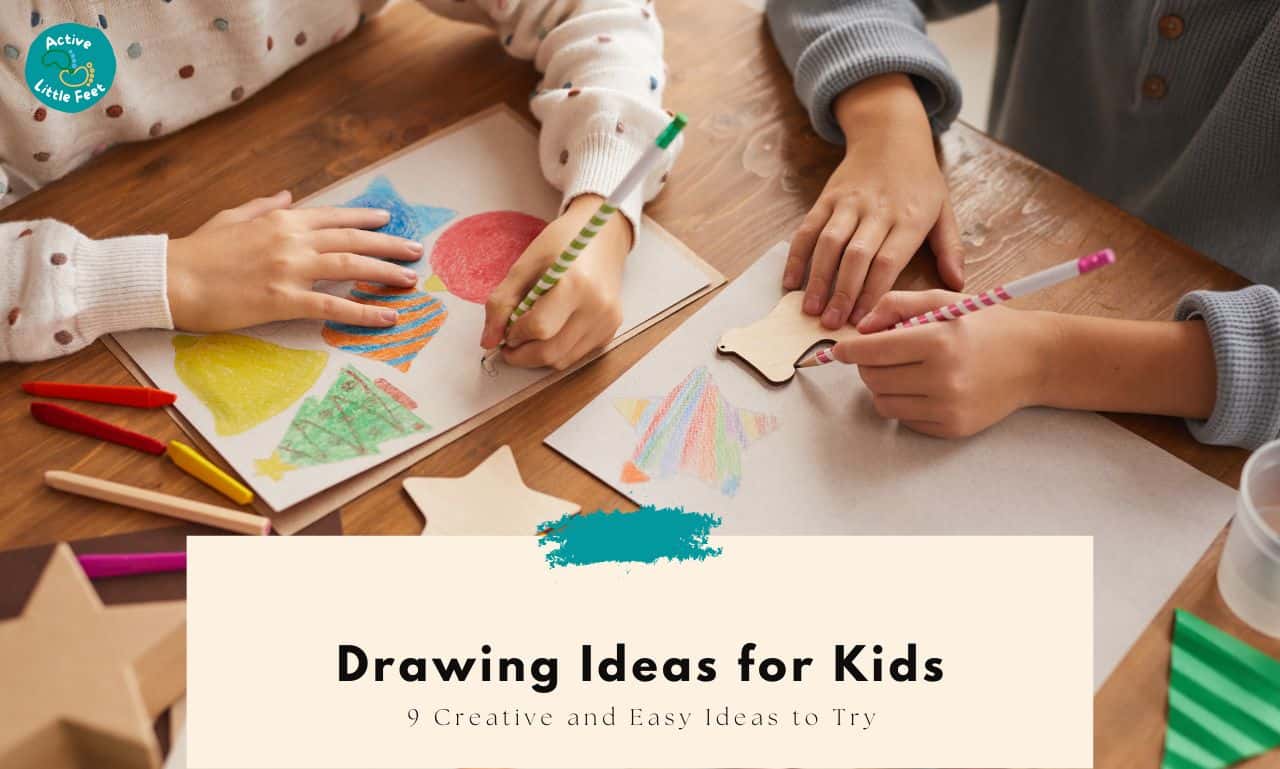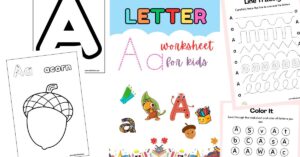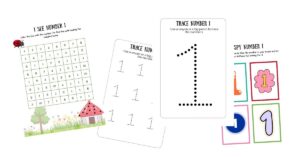Kids start scribbling early, making this an opportune time to improve their talents. After all, as Pablo Picasso famously stated, every child is an artist; the problem is how to remain an artist once they grow up. Finding fun and creative ideas will guide your child at every developmental stage and solidify their drawing skills. But first, you must figure out what your child can draw, depending on the age group.
Generally, your child can draw a house, animals, cars, trees, a boat, a rainbow, birds, a person, or an airplane. The options are endless, starting with basic shapes to advanced images. Of course, you should introduce ideas based on your child’s age and ability, but you can never run out of ideas.
In fact, here’s our article on how well your kids should draw. I highlight the different drawing development stages and what you should expect at every stage. Children start with scribbling, mastering lines and patterns, schematic stage, transition stage, and astute artists (around 12 years).
It takes time to nurture drawing techniques, but your kids will become little Picassos with practice and support. With that said, here are a few creative and easy ideas for all age groups.
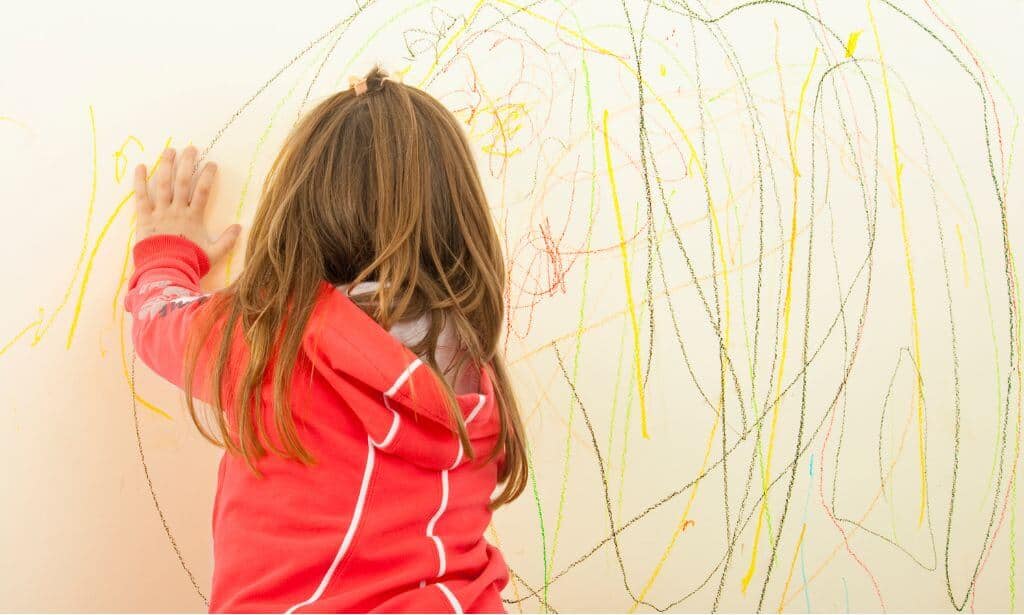
1. Random Scribbles and Lines
This drawing idea is specifically for 12-18-month-old children. At this age, the kids explore their curiosity and develop hand-eye coordination. Usually, they don’t have a strong grip and randomly scribble on paper and surfaces with pencils or crayons. So, why not find a plain book and encourage them to scribble around?
They’ll draw multiple lines and shapes and make a creative mess. Don’t expect too much, but encourage them to keep going. After all, the kids will learn to hold a pencil, differentiate colors, and identify objects. What’s more, scribbling improves the child’s palmar supinate grasp (12-15 months) to the digital pronate grasp (2-3 years).
2. Drawing with Blocks
Drawing with blocks is ideal for younger kids(3 years and below). Not to be confused with drawing actual blocks, this idea involves tracing images using physical blocks. Kids love blocks in all shapes, including circles, rectangles, squares, and ovals.
For this activity, arrange various blocks, a blank paper or drawing board, and pencils or crayons. The kids will place the block on the blank surface and trace the shape. Once they master tracing shapes, train them to fill out the shapes into actual images like mobile phones, faces, or cars.
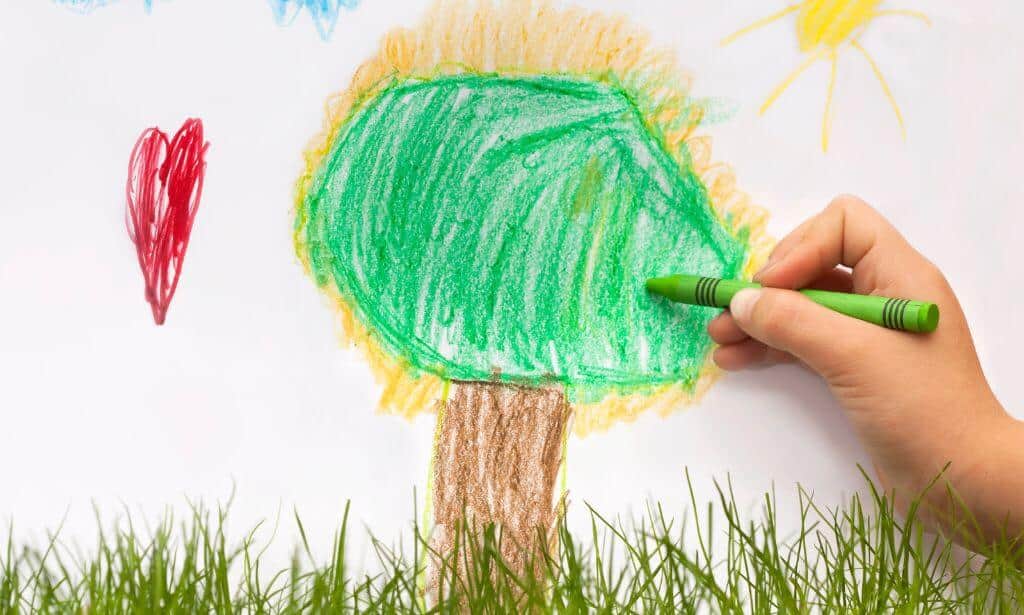
3. A Tree
Trees are simple and perfect for all age groups. You can start with basic tree images and improve the skills as the kids develop. For starters, kids will draw a simple tree base and trunk, add branches protruding from the trunk, and include leaves on the branches. Older kids can draw detailed tree images, highlighting swirls on the trunk and detailed lines on the leaves.
4. Buildings
Buildings are an excellent idea; you can find various drawing tutorials depending on their age. The kids can draw houses, post offices, commercial offices, schools, etc. Your role is to gauge your child’s ability and find images she can draw.
Usually, younger kids will excel at simple design. So, start with a house design when the base is a rectangle or square, then add the triangular roof. If they understand shapes, this drawing will be easy. Next, they’ll add a door, windows, a chimney, and a fence.
These drawings are straightforward, but as the kids master new techniques, encourage them to draw more complicated buildings. In fact, this is a great place to explore coloring and painting. In addition, you can read our article about drawing and painting to understand how they relate.
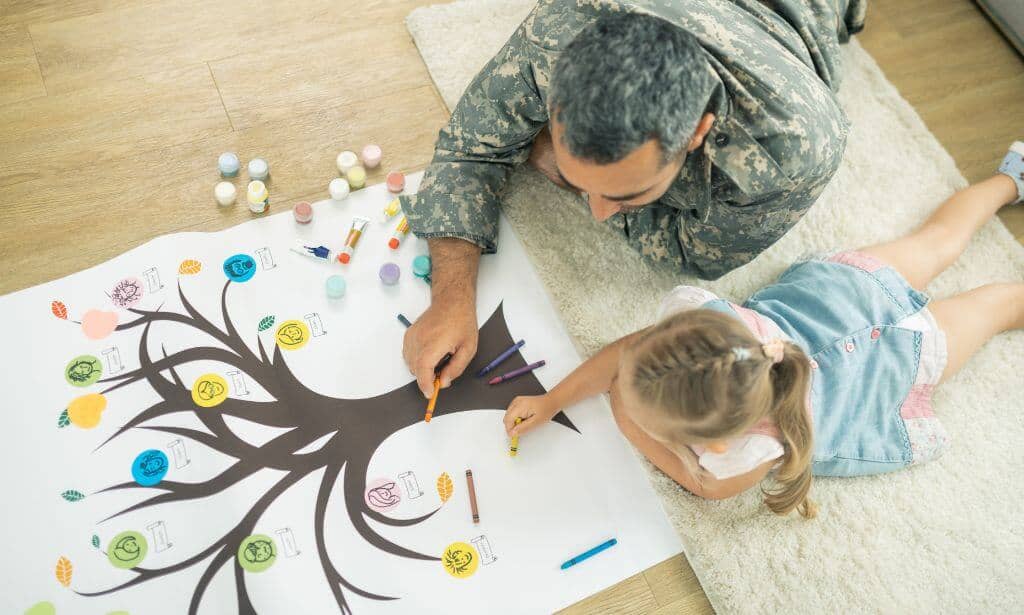
5. A Family Tree
Family is important, so it’s only right that the kids learn these relations at an early age. Drawing a family tree is the easiest way to teach kids about different family members and their relationships. For this activity, guide the kids as they draw a family tree, starting with mom and dad and their siblings (if they have any).
Next, include grandparents, aunts, uncles, and cousins. If the kids are younger, you can focus on immediate family members so they’re not confused.
6. Family Portraits
Besides the family tree, kids can also draw family portraits. These images don’t have to be detailed and artistic because they aim to teach them about relations and their identity. For example, they can draw stick images of mom, dad, siblings, and the family pet. Of course, the images will improve over time.
7. Animals
We all love animals, and most kids get excited at the thought of having a pet. Therefore, encourage the kids to draw their favorite animals, including dogs, cats, cows, rabbits, or hamsters. The list is endless; most of these animals have simple designs for kids learning to draw.
For example, if your kid loves corgis, here’s a step-by-step tutorial that is easy to follow. To make it fun, ask them to draw their pet or favorite animal first before you introduce more complex drawings.
8. Cartoon Characters
Yes! Everything, including Winnie the Pooh, Peppa Pig, SpongeBob, and Cocomelon, are fair play when it comes to drawing ideas for kids. Kids watch cartoons regularly and will jump at an opportunity to recreate their favorite characters. So, ask them to draw their favorite cartoon characters based on their imagination.
If that’s challenging, you can guide them or use a tutorial to make it easier. For the younger ones, encourage coloring, so the drawing is more realistic. On the other hand, older kids can take it a step further, coloring and using conversation doodles to highlight the characters’ favorite phrases.
However, if you’re coloring, ensure you get safe, child-friendly crayons. I have written an article that explains everything you should know about crayons and kid safety. Check it out.

9. The Rainbow
Rainbows are definitely a fun drawing idea. Not only will they practice their drawing skills, but drawing a rainbow also teaches color recognition. Moreover, rainbows are one of the easiest drawing ideas for kids.
The kids will start by drawing one curved line across the line, then two until they complete eight curved lines. These curved lines will separate seven curved rows that emulate the colors of the rainbow. Next, they’ll color each space differently, based on an actual rainbow. It’s a cute idea.
How to Encourage Kids to Draw
You have the drawing ideas, but what if your child can’t draw? Sometimes, parents encourage their kids to pick up talent early on. But the best way to encourage them is by helping them learn. So, if you’re interested in raising a little artist, here are a few tips.
1. Understand Different Drawing Techniques
There are different ways to draw, including crayon drawing and coloring, sketching, shading, doodles, chalkboard, and scribbling. Each drawing technique is based on the child’s age group and ability to grasp new ideas. Therefore, learning these techniques will help you understand where your child should start and how to support them at each stage.
2. Develop a Drawing Habit
Before your kid becomes a drawing prodigy, they’ll need lots of practice. Incorporating drawing into their routine is beneficial, so it becomes a habit. For example, set aside time for them to practice drawing before, after, or during playtime.
They can also draw on their way to school or a friend’s house. That way, they’ll gradually improve. In fact, you can join them on some days to make it fun, so they don’t view it as a chore.

3. Encourage Imagination and Experimenting
The ideas above are great, but you don’t have to pick a drawing idea for your kid daily. Some days, let their imagination run wild as they explore their creativity. For example, ask the kids to observe items or images and recreate what they see creatively.
Drawing from their memory taps into their talent and improves creativity. What’s more, give your kid the freedom to experiment with colors, pencil types, drawing surfaces, and more. When they’re free artistically, it’s easier for them to develop a passion for drawing.
4. Use a Professional
If your kid struggles with their drawing skills, consider using a professional. But sometimes, using a professional is beneficial, even when they’re not struggling. If you notice your child is talented and ahead of their age group, finding someone to improve their skills will go a long way in solidifying their talents.
Furthermore, working with a professional makes work easier, allowing you to focus on other areas of your child’s life. So, use a professional, but remember to oversee your kid’s progress.
5. Give Positive Feedback
Your child might not be great at drawing, but that shouldn’t be a reason to tear them down. Instead, as they learn to draw, refrain from negative comments and encourage positivity as much as possible.
When they complete a drawing, commend their work and gently tell them what to improve. Remember, although you’re being honest, harsh negative comments will discourage them from exploring their full potential.
Benefits of Drawing for Kids
- Improves fine motor skills and hand-eye coordination
- Encourages creativity and imaginative thinking
- Enhances emotional development and expression
- Facilitates cognitive development and visual perception
- Improves communication and concentration span
- Builds confidence
- It is fun for kids
- Improves performance in other school subjects like Mathematics
There you have it! Encouraging kids to draw has its perks and benefits in the long run. The ideas above are fun and engaging; we hope your kids will love them. In fact, this article gives you a full guide to the gifts you should buy for kids who love or are learning to draw. Be sure to check it out.

